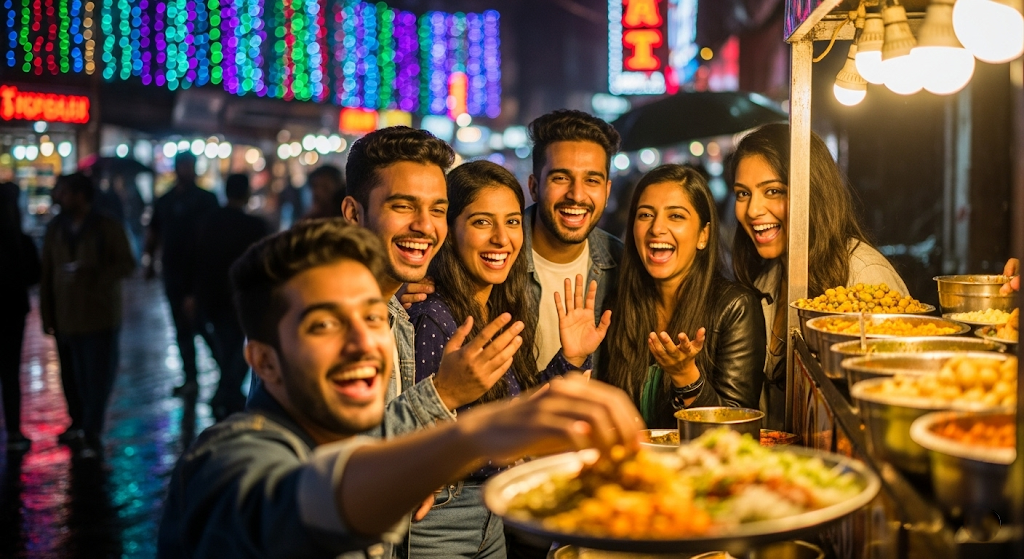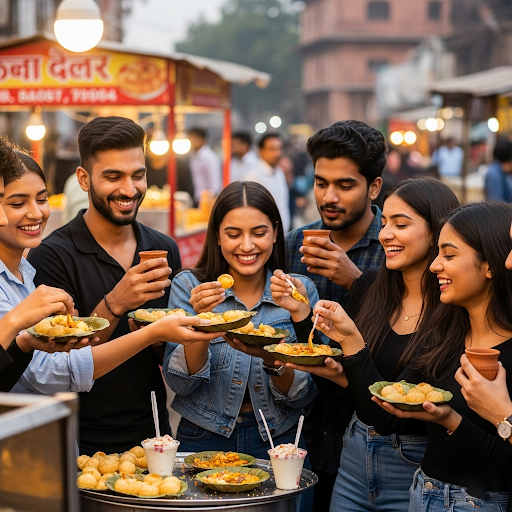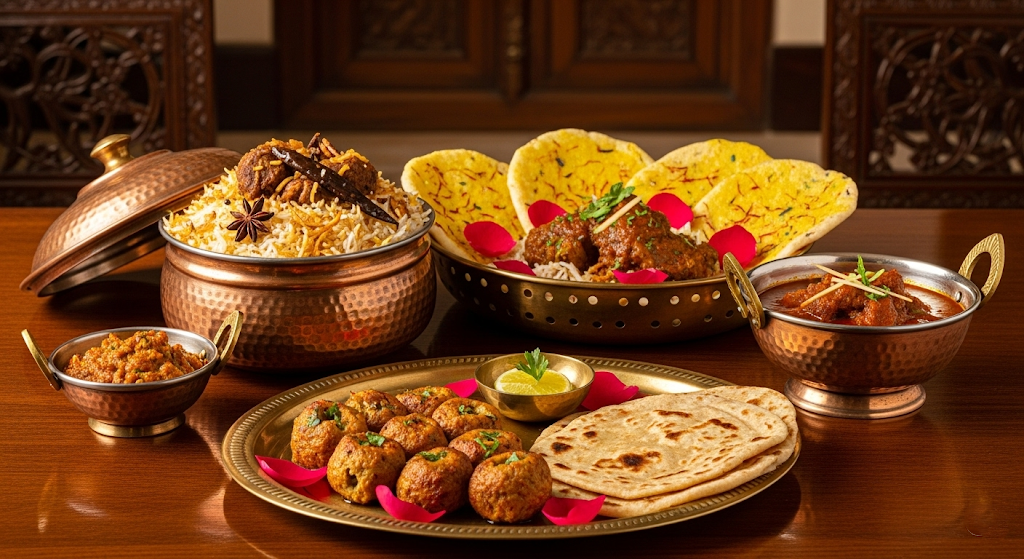 Lucknow: The Awadh region, centered around Lucknow and parts of present-day Uttar Pradesh, has always been more than a geographical entity—it has been a cultural stage where history, art, and cuisine intertwined to create a distinct identity. Among its many legacies, Awadhi cuisine stands tallest, reflecting centuries of refinement, innovation, and adaptation. From the opulent dastarkhwans of Nawabs to today’s bustling street corners and fine-dining tables worldwide, Awadh’s food journey mirrors its political, social, and cultural transformations.
Lucknow: The Awadh region, centered around Lucknow and parts of present-day Uttar Pradesh, has always been more than a geographical entity—it has been a cultural stage where history, art, and cuisine intertwined to create a distinct identity. Among its many legacies, Awadhi cuisine stands tallest, reflecting centuries of refinement, innovation, and adaptation. From the opulent dastarkhwans of Nawabs to today’s bustling street corners and fine-dining tables worldwide, Awadh’s food journey mirrors its political, social, and cultural transformations.
The Nawabi Era: A Symphony of Refinement (1722–1856)
Awadh’s culinary story begins in the early 18th century when Saadat Ali Khan became the first Nawab of Awadh. Lucknow soon emerged as a cultural powerhouse where Persian elegance, Central Asian techniques, and Indian traditions fused seamlessly. For the Nawabs, food was not mere sustenance but an art form, a performance staged with as much care as poetry and music.
The royal bawarchikhanas (kitchens) became laboratories of invention. Bawarchis (chefs) and rakabdars (master cooks) refined slow-cooking into the legendary dum pukht technique, where sealed pots preserved flavor, aroma, and texture. Signature dishes like biryani, korma, nihari, and kebabs began to define Awadhi culinary sophistication.
Some recipes carry delightful anecdotes. The famed galouti kebab, for instance, was created for Nawab Asaf-ud-Daulah, who had lost his teeth but not his appetite. Melt-in-the-mouth yet packed with flavor, it remains one of Awadh’s most beloved dishes.
Dining in Nawabi times was more than eating—it was theatre. The dastarkhwan, a spread of dishes served on silver platters, was accompanied by etiquette, storytelling, and music. Tehzeeb (grace and culture) infused every bite, reminding guests that food was also about bonds and belonging.
Yet, Nawabi cuisine was not only meat-heavy. Hindu influences brought vegetarian delights like tahiri (spiced rice) and jackfruit curries, while festivals like Muharram popularized haleem across communities. Sweets such as sheermaal, zarda, and nimish added festive cheer. By the mid-18th century, Awadhi cuisine had become a gastronomic language of identity and opulence.
Colonial Influence: Adaptation Amidst Upheaval (1856–1947)
The annexation of Awadh by the British in 1856 and the exile of Nawab Wajid Ali Shah to Calcutta disrupted the grandeur of the royal kitchens. Yet, rather than vanish, Awadhi cuisine dispersed and adapted. Chefs who once cooked for Nawabs found new patrons among British officials and Indian elites.
It was in Calcutta that Awadhi culinary traditions shaped Bengali food culture. The Calcutta biryani, lighter and adorned with potatoes, emerged as an Awadhi adaptation to local preferences. Back in Lucknow, taluqdars and the rising middle class became the new keepers of this heritage.
Street food culture blossomed in markets like Chowk and Aminabad. Here, kebabs and chaats took affordable, spicy avatars. The legendary Tunday kebab was born in this era—a robust cousin of the aristocratic galouti, accessible to ordinary folk yet retaining its royal DNA.
British preferences for mild flavors softened some kormas, while the arrival of tea gave rise to chai stalls. Nimish, the airy saffron-flavored dessert, often accompanied a steaming cup, creating pairings still cherished today. Through adaptation and resilience, Awadhi cuisine not only survived colonial upheaval but also extended its reach into the everyday lives of the people.

Post-Independence: Preserving Legacy, Popularizing Flavor (1947–2000)
With India’s independence came a new chapter. The princely courts and zamindari households lost their wealth, but Awadhi cuisine found its second home in restaurants and street-side eateries.
Lucknow’s food institutions—Tunday Kababi, Rahim’s Nihari, Royal Café—became the new custodians of heritage. What was once restricted to Nawabi tables now reached travelers, traders, and commoners. The 1960s and 70s saw iconic eateries preserving recipes like kakori kebabs, shahi tukda, and kormas, ensuring they remained household names.

This era also witnessed fusion. The influx of migrants post-Partition added Punjabi gravies and tandoor traditions, leading to new combinations. Awadhi naan might be served with butter chicken, and kebabs with dal makhni, reflecting a democratic mingling of flavors.
Cookbooks and festivals in the 1980s, particularly those curated by ITC Hotels, branded Awadhi cuisine as “heritage dining,” offering dum pukht delicacies to India’s urban elite. At the same time, vegetarian variations—paneer pasanda, dum aloo—entered menus, catering to growing middle-class sensibilities. By the turn of the millennium, Awadhi cuisine had established itself firmly as one of India’s crown jewels.
The Modern Foodie Scene: Innovation Meets Globalization (2000–2025)
The 21st century has catapulted Awadhi cuisine into global stardom. Fine-dining restaurants like ITC’s Dum Pukht and Indian Accent in Delhi have reinterpreted traditional recipes with contemporary flair. Galouti kebabs are now served as sliders, nihari finds a place inside bao buns, and molecular gastronomy has given biryani a deconstructed twist.
Yet, Lucknow’s streets remain the heart of the culinary culture. Rahim’s still serves nihari with kulchas to early morning crowds; Shukla’s chaat shop creates crunchy baskets of tangy flavors; Alamgir’s malai gilori continues to melt hearts. Food walks through Hazratganj and Chowk have turned into tourist rituals, while social media has amplified these experiences. A 30-second reel of a kebab sizzling on coal often reaches millions, turning age-old traditions into viral sensations.
Globalization has spread Awadhi cuisine far beyond India. From Dubai to New York, restaurants serving Awadhi biryani, kebabs, and sheermaal cater to diaspora nostalgia and international curiosity. However, the global stage has sparked debates on authenticity, as flavors are sometimes diluted for foreign palates.
Modernity has also brought health-conscious adaptations. Vegan galouti made with jackfruit, low-oil kormas, gluten-free breads, and air-fried kebabs are now part of menus, addressing new lifestyle choices without losing cultural essence. Food delivery platforms like Zomato and Swiggy have ensured that Lucknow’s kebabs and biryanis reach homes in minutes, democratizing access further.

Awadh on a Platter
Despite its immense popularity, Awadhi cuisine faces pressing challenges. Traditional techniques like dum pukht require time and skilled hands, increasingly scarce in today’s fast-paced world. Rising ingredient costs—especially saffron and dry fruits—add to the pressure. The gradual decline of trained bawarchis raises questions about who will carry forward authentic recipes.
Moreover, the younger generation’s fascination with international cuisines poses a cultural dilemma. Can kebabs compete with sushi rolls and burgers? Many chefs believe the answer lies in innovation—retaining the essence of Awadhi flavors while presenting them in new formats.
Looking ahead, sustainability may shape the future of Awadhi food. Plant-based kebabs, locally sourced ingredients, and eco-friendly dining practices could ensure both heritage and responsibility. Culinary schools are increasingly documenting traditional techniques, while AI-driven recipe platforms may help preserve lost methods for future generations.
The Enduring Soul of Awadhi Food
Over 250 years, Awadhi cuisine has journeyed from royal courts to bustling markets, from silver platters to cloud kitchens, from Lucknow’s narrow lanes to global restaurant chains. What began as Nawabi indulgence has become a cultural symbol—of refinement, resilience, and communal bonding.
Every bite of a galouti kebab or spoonful of dum biryani still carries whispers of history—the tehzeeb of the Nawabs, the adaptability of colonial times, the democratization of independence, and the innovation of modernity.
Awadh’s cuisine is not merely about food—it is about memory, identity, and belonging. As long as Lucknow’s streets fill with the aromas of kebabs and biryanis, the legacy of Awadh will remain alive, delicious, and eternal.





